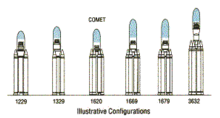Conestoga (rocket)
The Conestoga rocket was a launch vehicle for small satellites in low orbits, privately developed by Space Service (SSI), from 1990 EER Systems Corporation .
Conestoga-1
The Conestoga-1 was an attempt based abgerüsteter on the second stage Minuteman - intercontinental ballistic missiles , similar to the Aries to develop rocket, but with two additional upper stages, a launcher for small satellites. An experimental rocket with dummies of the upper stages was successfully tested on September 9, 1982 on a suborbital flight from the Texan island of Matagorda . The full rocket, however, was never flown because no orders could be won. The SSI company then developed the modular Conestoga 1000 rocket.
Conestoga 1000
The Conestoga 1000 series was a modular rocket made up of tried and tested components that had nothing in common with the earlier Conestoga 1 design. It was based on up to sevenfold bundled Castor IV A / B rocket motors, which were used in large numbers on the Delta rocket. A Castor-IV-B booster served as the rocket's central stage. Depending on the configuration, this block contained one or two upper solids stages and optionally the hydrazine- operated correction stage HMACS (Hydrazine Maneuvering and Attitude Control System).
Due to the modular structure, the rocket could be produced in several variants with different payload capacities. To name the versions of the rocket, a four-digit designation system was used , similar to the Delta . Individual digits were assigned using the following key:
- the first digit corresponded to the type of the first stage and the side boosters.
- the second number denoted the number of side boosters.
- the third digit stood for the first high school type
- the fourth digit stood for the type of the second upper level ( 0 if none available)
| rocket | stages | 1st stage | 2nd stage | 3rd stage | 4th stage | 5th stage | Payload (kg) |
|---|---|---|---|---|---|---|---|
| Conestoga 1229 | 4th | 2 Castor-4B | 1 Castor-4B | Star-48V | HMACS | - | 363 kg |
| Conestoga 1379 | 4th | 3 Castor-4B | 1 Castor-4B | Star-63V | HMACS | - | 770 kg |
| Conestoga 1620 | 4th | 4 Castor-4A / B | 2 Castor-4B | 1 Castor-4B | Star-48V | - | 1179 kg |
| Conestoga 1669 | 5 | 4 Castor-4A / B | 2 Castor-4B | 1 Castor-4B | Star-63D | HMACS | 1361 kg |
| Conestoga 1679 | 5 | 4 Castor-4A / B | 2 Castor-4B | 1 Castor-4B | Star-63V | HMACS | 1497 kg |
| Conestoga 3632 | 5 | 4 Castor-4A / B-XL | 2 Castor-4B-XL | 1 Castor-4B-XL | Orion-50 | Star-48V | 2141 kg |
There was only one flight in place Conestoga-1620 configuration, which on 23. October 1995 the microgravity research satellite METEOR one of NASA from the Wallops Flight Facility should bring out into space. Due to a control problem, the missile exploded shortly after launch. The Conestoga missile was in direct competition with the Athena and the Taurus . Due to a lack of demand, there were no further flights.

